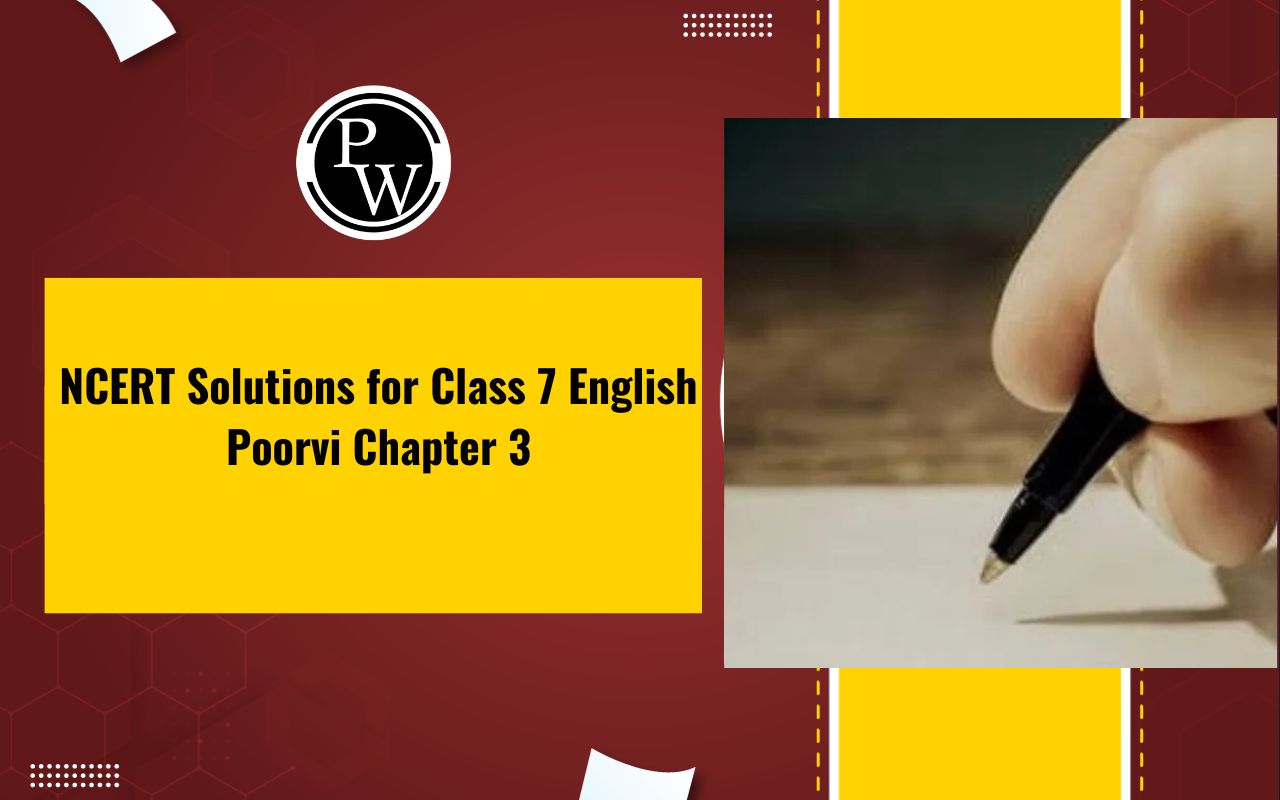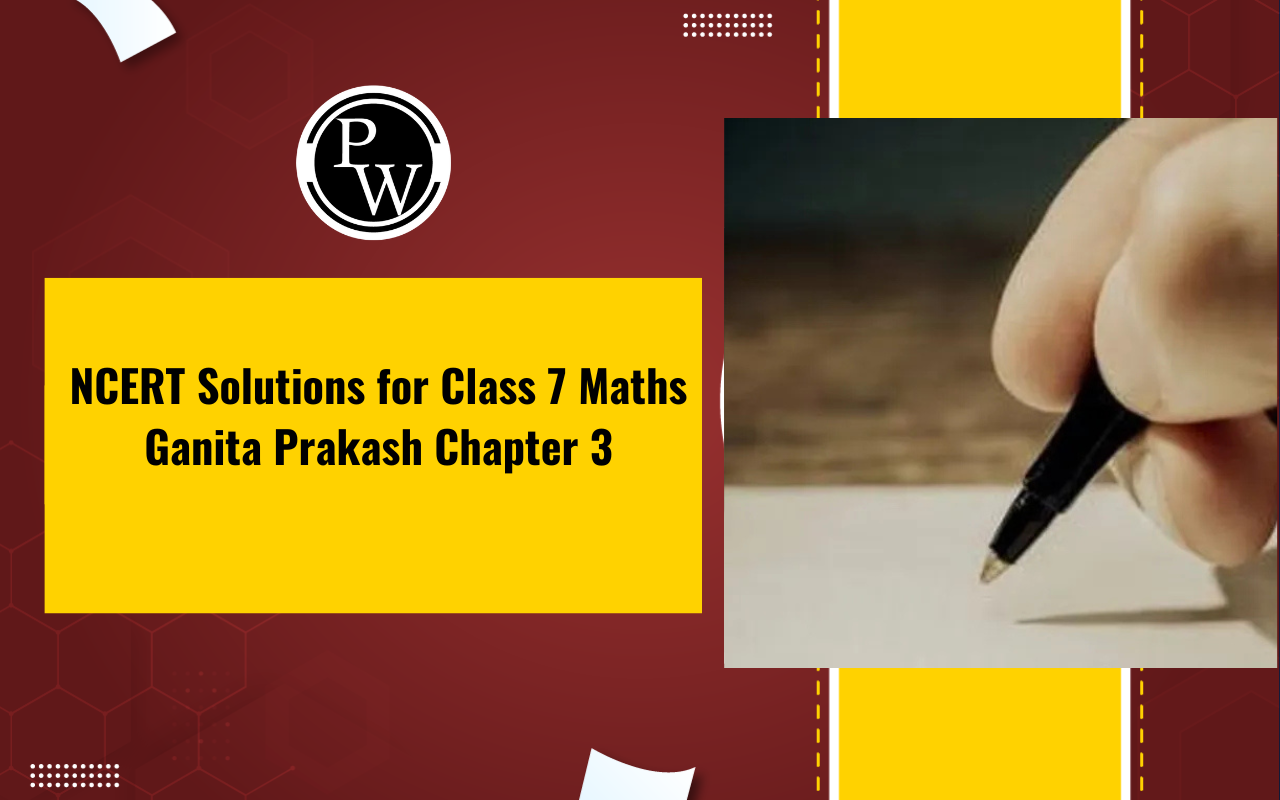

NCERT Solutions for Class 7 Maths Chapter 11
NCERT Solutions for Class 7 Maths Chapter 11: NCERT Solutions for Class 7 Maths Chapter 11 cover the important concepts of perimeter and area. This chapter introduces students to the fundamental principles of measuring the boundary length (perimeter) and enclosed space (area) of geometric shapes like rectangles, squares, and triangles. The solutions provided in this chapter provide step-by-step explanations to help students understand and solve problems related to calculating perimeter and area accurately. By practicing with these solutions, students can strengthen their grasp of these essential geometric concepts and improve their problem-solving skills.
NCERT Solutions for Class 7 Maths Chapter 11 PDF
The PDF link for NCERT Solutions for Class 7 Maths Chapter 11 is provided below. This PDF contains detailed solutions to all the questions presented in the chapter. Students can use these solutions to enhance their understanding of the topics covered in Chapter 11, "Perimeter and Area," by following step-by-step explanations. Accessing the PDF will be beneficial for students preparing for their exams, as it offers a valuable resource for practicing and mastering the concepts related to perimeter and area.NCERT Solutions for Class 7 Maths Chapter 11 PDF
NCERT Solutions for Class 7 Maths Chapter 11 Perimeter and Area
Exercise 11.1 Page: 2081. The length and breadth of a rectangular piece of land are 500 m and 300 m, respectively. Find
(i) Its area (ii) the cost of the land, if 1 m 2 of the land costs ₹ 10,000.
Solution:-
From the question, it is given that Length of the rectangular piece of land = 500 m Breadth of the rectangular piece of land = 300 m Then, (i) Area of rectangle = Length × Breadth = 500 × 300 = 150000 m 2 (ii) Cost of the land for 1 m 2 = ₹ 10000 Cost of the land for 150000 m 2 = 10000 × 150000 = ₹ 15000000002. Find the area of a square park whose perimeter is 320m.
Solution:-
From the question, it is given that Perimeter of the square park = 320 m 4 × Length of the side of park = 320 m Then, Length of the side of the park = 320/4 = 80 m So, the area of the square park = (Length of the side of the park) 2 = 80 2 = 6400 m 23. Find the breadth of a rectangular plot of land if its area is 440 m 2 and the length is 22 m. Also, find its perimeter.
Solution:-
From the question, it is given that Area of the rectangular plot = 440 m 2 Length of the rectangular plot = 22 m We know that, Area of the rectangle = Length × Breadth 440 = 22 × Breadth Breadth = 440/22 Breadth = 20 m Then, Perimeter of the rectangle = 2(Length + Breadth) = 2 (22 + 20) = 2(42) = 84 m ∴ Perimeter of the rectangular plot is 84 m.4. The perimeter of a rectangular sheet is 100 cm. If the length is 35 cm, find its breadth.
Also, find the area.
Solution:-
From the question, it is given that Perimeter of the rectangular sheet = 100 cm Length of the rectangular sheet = 35 cm We know that, Perimeter of the rectangle = 2 (Length + Breadth) 100 = 2 (35 + Breadth) (100/2) = 35 + Breadth 50 – 35 = Breadth Breadth = 15 cm Then, Area of the rectangle = Length × Breadth = 35 × 15 = 525 cm 2 ∴ Area of the rectangular sheet is 525 cm 25. The area of a square park is the same as that of a rectangular park. If the side of the square park is 60 m and the length of the rectangular park is 90 m, find the breadth of the rectangular park.
Solution:-
From the question, it is given that The area of a square park is the same as that of a rectangular park. Side of the square park = 60 m Length of the rectangular park = 90 m We know that, Area of the square park = (One of the sides of the square) 2 = 60 2 = 3600 m 2 Area of the rectangular park = 3600 m 2 … [∵ given] Length × Breadth = 3600 90 × Breadth = 3600 Breadth = 3600/90 Breadth = 40 m6. A wire is in the shape of a rectangle. Its length is 40 cm, and its breadth is 22 cm. If the same wire is rebent in the shape of a square, what will be the measure of each side?
Also, find which shape encloses more area.
Solution:-
By reading the question, we can conclude that the perimeter of the square is the same as the perimeter of the rectangle. From the question, it is given that Length of the rectangle = 40 cm Breadth of the square = 22 cm Then, Perimeter of the rectangle = Perimeter of the Square 2 (Length + Breadth) = 4 × side 2 (40 + 22) = 4 × side 2 (62) = 4 × side 124 = 4 × side Side = 124/4 Side = 31 cm So, the area of the rectangle = (Length × Breadth) = 40 × 22 = 880 cm 2 Area of square = side 2 = 31 2 = 31 × 31 = 961 cm 2 ∴ Square-shaped wire encloses more area.7. The perimeter of a rectangle is 130 cm. If the breadth of the rectangle is 30 cm, find its length. Also, find the area of the rectangle.
Solution:-
From the question, it is given that Perimeter of the rectangle = 130 cm Breadth of the rectangle = 30 We know that Perimeter of rectangle = 2 (Length + Breadth) 130 = 2 (length + 30) 130/2 = length + 30 Length + 30 = 65 Length = 65 – 30 Length = 35 cm Then, Area of the rectangle = Length × Breadth = 35 × 30 = 1050 cm 28. A door of length 2 m and breadth 1 m is fitted in a wall. The length of the wall is 4.5 m, and the breadth is 3.6 m (Fig). Find the cost of whitewashing the wall if the rate of whitewashing the wall is ₹ 20 per m 2 .

Solution:-
From the question, it is given that Length of the door = 2 m Breadth of the door = 1 m Length of the wall = 4.5 m Breadth of the wall = 3.6 m Then, Area of the door = Length × Breadth = 2 × 1 = 2 m 2 Area of the wall = Length × Breadth = 4.5 × 3.6 = 16.2 m 2 So, area to be whitewashed = 16.2 – 2 = 14.2 m 2 Cost of whitewashing 1 m 2 area = ₹ 20 Hence, the cost of whitewashing 14.2 m 2 area = 14.2 × 20 = ₹ 284Exercise 11.2 Page: 216
1. Find the area of each of the following parallelograms.
(a)

Solution:-
From the figure, Height of parallelogram = 4 cm Base of parallelogram = 7 cm Then, Area of parallelogram = Base × Height = 7 × 4 = 28 cm 2(b)

Solution:-
From the figure, Height of parallelogram = 3 cm Base of parallelogram = 5 cm Then, Area of parallelogram = Base × Height = 5 × 3 = 15 cm 2(c)

Solution:-
From the figure, Height of parallelogram = 3.5 cm Base of parallelogram = 2.5 cm Then, Area of parallelogram = Base × Height = 2.5 × 3.5 = 8.75 cm 2(d)

Solution:-
From the figure, Height of parallelogram = 4.8 cm Base of parallelogram = 5 cm Then, Area of parallelogram = Base × Height = 5 × 4.8 = 24 cm 2(e)

Solution:-
From the figure, Height of parallelogram = 4.4 cm Base of parallelogram = 2 cm Then, Area of parallelogram = Base × Height = 2 × 4.4 = 8.8 cm 22. Find the area of each of the following triangles.
(a)

Solution:-
From the figure, Base of triangle = 4 cm Height of height = 3 cm Then, Area of triangle = ½ × Base × Height = ½ × 4 × 3 = 1 × 2 × 3 = 6 cm 2(b)

Solution:-
From the figure, Base of triangle = 3.2 cm Height of height = 5 cm Then, Area of triangle = ½ × Base × Height = ½ × 3.2 × 5 = 1 × 1.6 × 5 = 8 cm 2(c)

Solution:-
From the figure, Base of triangle = 3 cm Height of height = 4 cm Then, Area of triangle = ½ × Base × Height = ½ × 3 × 4 = 1 × 3 × 2 = 6 cm 2(d)

Solution:-
From the figure, Base of triangle = 3 cm Height of height = 2 cm Then, Area of triangle = ½ × Base × Height = ½ × 3 × 2 = 1 × 3 × 1 = 3 cm 23. Find the missing values.
| S.No. | Base | Height | Area of the Parallelogram |
| a. | 20 cm | 246 cm 2 | |
| b. | 15 cm | 154.5 cm 2 | |
| c. | 8.4 cm | 48.72 cm 2 | |
| d. | 15.6 cm | 16.38 cm 2 |
Solution:-
(a)
From the table, Base of parallelogram = 20 cm Height of parallelogram =? Area of the parallelogram = 246 cm 2 Then, Area of parallelogram = Base × Height 246 = 20 × height Height = 246/20 Height = 12.3 cm ∴ Height of the parallelogram is 12.3 cm.(b)
From the table, Base of parallelogram =? Height of parallelogram =15 cm Area of the parallelogram = 154.5 cm 2 Then, Area of parallelogram = Base × Height 154.5 = base × 15 Base = 154.5/15 Base = 10.3 cm ∴ Base of the parallelogram is 10.3 cm.(c)
From the table, Base of parallelogram =? Height of parallelogram =8.4 cm Area of the parallelogram = 48.72 cm 2 Then, Area of parallelogram = Base × Height 48.72 = base × 8.4 Base = 48.72/8.4 Base = 5.8 cm ∴ Base of the parallelogram is 5.8 cm.(d)
From the table, Base of parallelogram = 15.6 cm Height of parallelogram =? Area of the parallelogram = 16.38 cm 2 Then, Area of parallelogram = Base × Height 16.38 = 15.6 × height Height = 16.38/15.6 Height = 1.05 cm ∴ Height of the parallelogram is 1.05 cm.| S.No. | Base | Height | Area of the Parallelogram |
| a. | 20 cm | 12.3 cm | 246 cm 2 |
| b. | 10.3 cm | 15 cm | 154.5 cm 2 |
| c. | 5.8 cm | 8.4 cm | 48.72 cm 2 |
| d. | 15.6 cm | 1.05 | 16.38 cm 2 |
4. Find the missing values.
| Base | Height | Area of Triangle |
| 15 cm | 87 cm 2 | |
| 31.4 mm | 1256 mm 2 | |
| 22 cm | 170.5 cm 2 |
Solution:-
(a)
From the table, Height of triangle =? Base of triangle = 15 cm Area of the triangle = 16.38 cm 2 Then, Area of triangle = ½ × Base × Height 87 = ½ × 15 × height Height = (87 × 2)/15 Height = 174/15 Height = 11.6 cm ∴ Height of the triangle is 11.6 cm.(b)
From the table, Height of triangle =31.4 mm Base of triangle =? Area of the triangle = 1256 mm 2 Then, Area of triangle = ½ × Base × Height 1256 = ½ × base × 31.4 Base = (1256 × 2)/31.4 Base = 2512/31.4 Base = 80 mm = 8 cm ∴ Base of the triangle is 80 mm or 8 cm.(c)
From the table, Height of triangle =? Base of triangle = 22 cm Area of the triangle = 170.5 cm 2 Then, Area of triangle = ½ × Base × Height 170.5 = ½ × 22 × height 170.5 = 1 × 11 × height Height = 170.5/11 Height = 15.5 cm ∴ Height of the triangle is 15.5 cm.5. PQRS is a parallelogram (Fig 11.23). QM is the height from Q to SR, and QN is the height from Q to PS. If SR = 12 cm and QM = 7.6 cm. Find:
(a) The area of the parallelogram PQRS (b) QN, if PS = 8 cm

Fig 11.23
Solution:-
From the question, it is given that SR = 12 cm, QM = 7.6 cm (a) We know that, Area of the parallelogram = Base × Height = SR × QM = 12 × 7.6 = 91.2 cm 2 (b) Area of the parallelogram = Base × Height 91.2 = PS × QN 91.2 = 8 × QN QN = 91.2/8 QN = 11.4 cm6. DL and BM are the heights on sides AB and AD, respectively, of parallelogram ABCD (Fig 11.24). If the area of the parallelogram is 1470 cm 2 , AB = 35 cm and AD = 49 cm, find the length of BM and DL.

Fig 11.24
Solution:-
From the question, it is given that Area of the parallelogram = 1470 cm 2 AB = 35 cm AD = 49 cm Then, We know that, Area of the parallelogram = Base × Height 1470 = AB × BM 1470 = 35 × DL DL = 1470/35 DL = 42 cm And, Area of the parallelogram = Base × Height 1470 = AD × BM 1470 = 49 × BM BM = 1470/49 BM = 30 cm7. ΔABC is right-angled at A (Fig 11.25). AD is perpendicular to BC. If AB = 5 cm, BC = 13 cm, and AC = 12 cm, find the area of ΔABC. Also, find the length of AD.

Fig 11.25
Solution:-
From the question, it is given that AB = 5 cm, BC = 13 cm, AC = 12 cm Then, We know that, Area of the ΔABC = ½ × Base × Height = ½ × AB × AC = ½ × 5 × 12 = 1 × 5 × 6 = 30 cm 2 Now, Area of ΔABC = ½ × Base × Height 30 = ½ × AD × BC 30 = ½ × AD × 13 (30 × 2)/13 = AD AD = 60/13 AD = 4.6 cm8. ΔABC is isosceles with AB = AC = 7.5 cm and BC = 9 cm (Fig 11.26). The height AD from A to BC is 6 cm. Find the area of ΔABC. What will be the height from C to AB, i.e., CE?

Solution:-
From the question, it is given that AB = AC = 7.5 cm, BC = 9 cm, AD = 6cm Then, Area of ΔABC = ½ × Base × Height = ½ × BC × AD = ½ × 9 × 6 = 1 × 9 × 3 = 27 cm 2 Now, Area of ΔABC = ½ × Base × Height 27 = ½ × AB × CE 27 = ½ × 7.5 × CE (27 × 2)/7.5 = CE CE = 54/7.5 CE = 7.2 cm Exercise 11.3 Page: 2231. Find the circumference of the circle with the following radius. (Take π = 22/7)
(a) 14 cm
Solution:-
Given, the radius of the circle = 14 cm Circumference of the circle = 2πr = 2 × (22/7) × 14 = 2 × 22 × 2 = 88 cm(b) 28 mm
Solution:-
Given, the radius of the circle = 28 mm Circumference of the circle = 2πr = 2 × (22/7) × 28 = 2 × 22 × 4 = 176 mm(c) 21 cm
Solution:-
Given, the radius of the circle = 21 cm Circumference of the circle = 2πr = 2 × (22/7) × 21 = 2 × 22 × 3 = 132 cm2. Find the area of the following circles, given that
(a) Radius = 14 mm (Take π = 22/7)
Solution:
Given, the radius of the circle = 14 mm Then, Area of the circle = πr 2 = 22/7 × 14 2 = 22/7 × 196 = 22 × 28 = 616 mm 2(b) Diameter = 49 m
Solution:
Given, the diameter of the circle (d) = 49 m We know that radius (r) = d/2 = 49/2 = 24.5 m Then, Area of the circle = πr 2 = 22/7 × (24.5) 2 = 22/7 × 600.25 = 22 × 85.75 = 1886.5 m 2(c) Radius = 5 cm
Solution:
Given, the radius of the circle = 5 cm Then, Area of the circle = πr 2 = 22/7 × 5 2 = 22/7 × 25 = 550/7 = 78.57 cm 23. If the circumference of a circular sheet is 154 m, find its radius. Also, find the area of the sheet. (Take π = 22/7)
Solution:-
From the question, it is given that Circumference of the circle = 154 m Then, We know that the circumference of the circle = 2πr 154 = 2 × (22/7) × r 154 = 44/7 × r r = (154 × 7)/44 r = (14 × 7)/4 r = (7 × 7)/2 r = 49/2 r = 24.5 m Now, Area of the circle = πr 2 = 22/7 × (24.5) 2 = 22/7 × 600.25 = 22 × 85.75 = 1886.5 m 2 So, the radius of the circle is 24.5, and the area of the circle is 1886.5.4. A gardener wants to fence a circular garden of diameter 21m. Find the length of the rope he needs to purchase, if he makes 2 rounds of the fence. Also, find the cost of the rope, if it costs ₹ 4 per meter. (Take π = 22/7)

Solution:-
From the question, it is given that Diameter of the circular garden = 21 m We know that radius (r) = d/2 = 21/2 = 10.5 m Then, Circumference of the circle = 2πr = 2 × (22/7) × 10.5 = 462/7 = 66 m So, the length of rope required = 2 × 66 = 132 m Cost of 1 m rope = ₹ 4 [given] Cost of 132 m rope = ₹ 4 × 132 = ₹ 5285. From a circular sheet of radius 4 cm, a circle of radius 3 cm is removed. Find the area of the remaining sheet. (Take π = 3.14)
Solution:-
From the question, it is given that Radius of circular sheet R = 4 cm A circle of radius to be removed r = 3 cm Then, The area of the remaining sheet = πR 2 – πr 2 = π (R 2 – r 2 ) = 3.14 (4 2 – 3 2 ) = 3.14 (16 – 9) = 3.14 × 7 = 21.98 cm 2 So, the area of the remaining sheet is 21.98 cm 2 .6. Saima wants to put lace on the edge of a circular table cover of diameter 1.5 m. Find the length of the lace required, and also, find its cost if one meter of the lace costs ₹ 15. (Take π = 3.14)
Solution:-
From the question, it is given that Diameter of the circular table = 1.5 m We know that radius (r) = d/2 = 1.5/2 = 0.75 m Then, Circumference of the circle = 2πr = 2 × 3.14 × 0.75 = 4.71 m So, the length of the lace = 4.71 m Cost of 1 m lace = ₹ 15 [given] Cost of 4.71 m lace = ₹ 15 × 4.71 = ₹ 70.657. Find the perimeter of the adjoining figure, which is a semicircle, including its diameter.

Solution:-
From the question, it is given that Diameter of semi-circle = 10 cm We know that radius (r) = d/2 = 10/2 = 5 cm Then, Circumference of the semi-circle = πr + 2r = 3.14(5) + 2(5) = 5 [3.14+ 2] = 5 [5.14] Therefore, the perimeter of the semicircle = 25.7 cmNCERT Solutions For Class 7 Maths Chapter 11 FAQs
How can students benefit from using the PDF?
What is the perimeter of a shape?
How is area different from perimeter?
How do you calculate the area of a rectangle?











